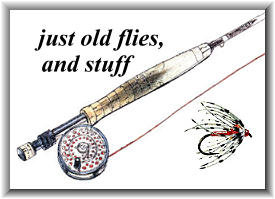I am, and have always been, a pack rat. I save
cuttings from the floor when I tie flies, pictures
of flies from catalogs, and the Internet. I don't
think I've ever lost a fly fishing book. My mind
works the same way; it's a collection of what I
have observed, heard and read over the years,
not well indexed, odd bits of which come back
to haunt me from time to time.
This week I was in my local fly shop browsing when
I overheard a discussion on what beetle was hot on
the local river. It was a foam creation with 6 rubber
legs that were so small and fragile that even a half
pint of Foster's Lager would prevent anyone I know
from finding them on the tying bench let alone
attaching them to a piece of used "flip flop."
After trying to tie a dozen beetles with those
delicate legs I finally ask myself if they were
really necessary and gave up on bugs with tiny
fragile legs. One good trout would finish them,
if a tier could attach them to the bug in the
first place, and out of the recesses of my pack
rat mind charged the slightly dusty memory of
Corkers.

If you are not drawing social security you are
too young to remember Corkers and the controversy
they generated. They were just painted bits of cork
glued to a bare hook that were supposed to represent
hoppers, beetles, ants, inchworms and maybe the morning
after visions of a mescal addict. Bill McIntyre of
Pittsburgh Pennsylvania manufactured them by the bushel.
I always thought he hired stoned hippies to paint them
those weird colors, mostly odd yellows and greens.
Weird looking they surely were but they really caught
fish. Splat that piece of cork down hard in a mirror
smooth section of a river and fish would come six feet
or more to lunch on them. They certainly were effective.
No legs, wings, antennae; just cork and a hook and what
ever paint was left over from last years home improvement
project. Now comes the controversy.
Since these "flies" were made from just a hook and a
painted piece of cork many considered them lures and
you could be arrested for fishing them on most fly
only stretches. I was once informed by a game warden
on the Au Sable river in Michigan that fishing Corkers
was a "no no" on his river. The founder of Thomas and
Thomas told me that he delayed marketing Corkers until
they were generally considered ethical. He then ran a
full page of them in his catalog at about a dollar each.
(The photos shown here are from that catalog). Many
fishermen still consider them lures, and I would be
hesitant to show them to a warden on most fly only water
even today. The "If it ain't got hair, fur or feathers
on it, it's not a fly" view, like the early radio hero
"The Shadow," still clouds men's minds.

Bill McIntyre still had an advertisement running
in 1999 for his Corkers, but this year I was unable
to locate him or his family. He may not have invented
the cork fly concept but he surely popularized it,
a minimalist approach to fly tying showing again
that a fly doesn't have to be an exact imitation
to be successful. He wasn't afraid to step outside
the box when he designed his flies. The trout never
had a doubt about them even if many fishermen and
regulators did.
I NEVER DID THINK THOSE TROUT HAD TO HAVE ALL THOSE
LITTLE LEGS ON THEIR TERRESTERALS.
Bill, those little legs and wing cases and such
almost got me. I'm glad I finally remembered you
and your marvelous minimalist flies. I almost
forgot your message. It's a shame some did.
Presentation rules.
Addendum:
I decided to write this addendum only after
wrestling with my conscience for several days.
The most famous Corker fly was the pellet fly.
Presented over hatchery trout it was devastating,
 this no doubt contributed to the low status of
the Corker series. I know several fishermen that
have taken over fifty recently stocked trout at
a time without taking a step. While I have never
used this fly (crossed fingers) one fly shop told
me it was his best seller in the series, but he
was located near a hatchery in Arkansas. Thomas
and Thomas hid the fly in the lower right hand corner
of their catalog Corker page. They must have also
wrestled with a conscience or two. One should always
wear a burlap sack creel when fishing that fly...somehow
it just seems to fit the act. ~ Old rupe
this no doubt contributed to the low status of
the Corker series. I know several fishermen that
have taken over fifty recently stocked trout at
a time without taking a step. While I have never
used this fly (crossed fingers) one fly shop told
me it was his best seller in the series, but he
was located near a hatchery in Arkansas. Thomas
and Thomas hid the fly in the lower right hand corner
of their catalog Corker page. They must have also
wrestled with a conscience or two. One should always
wear a burlap sack creel when fishing that fly...somehow
it just seems to fit the act. ~ Old rupe
|





